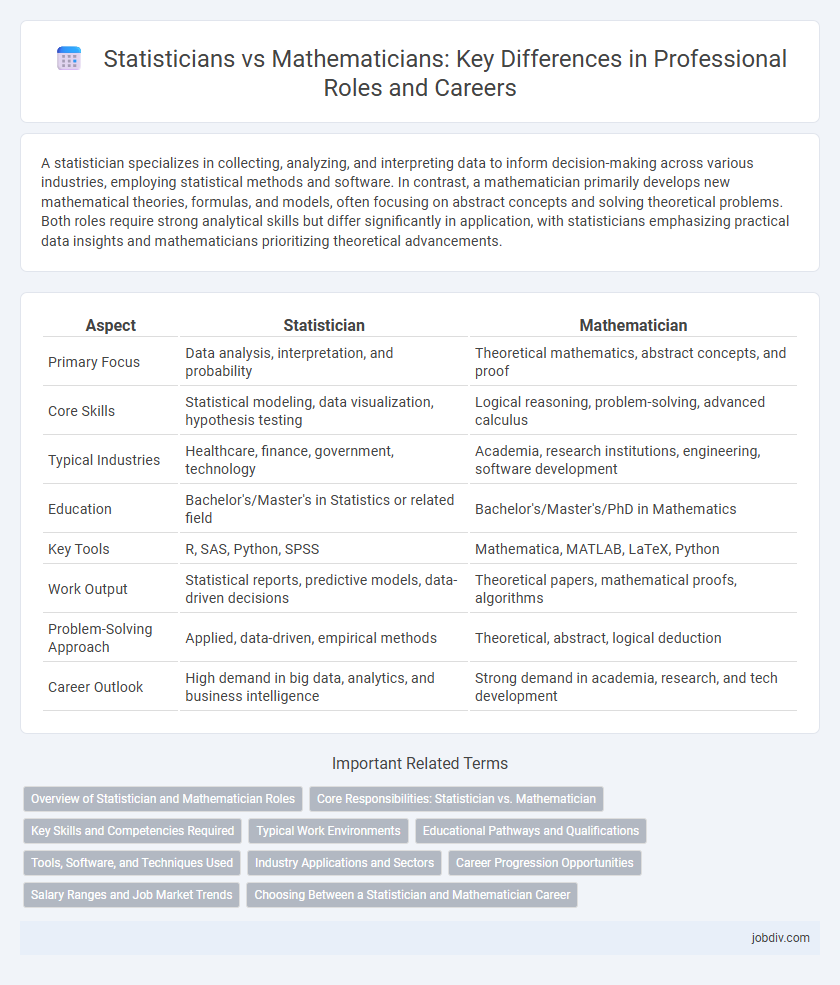A statistician specializes in collecting, analyzing, and interpreting data to inform decision-making across various industries, employing statistical methods and software. In contrast, a mathematician primarily develops new mathematical theories, formulas, and models, often focusing on abstract concepts and solving theoretical problems. Both roles require strong analytical skills but differ significantly in application, with statisticians emphasizing practical data insights and mathematicians prioritizing theoretical advancements.
Table of Comparison
| Aspect | Statistician | Mathematician |
|---|---|---|
| Primary Focus | Data analysis, interpretation, and probability | Theoretical mathematics, abstract concepts, and proof |
| Core Skills | Statistical modeling, data visualization, hypothesis testing | Logical reasoning, problem-solving, advanced calculus |
| Typical Industries | Healthcare, finance, government, technology | Academia, research institutions, engineering, software development |
| Education | Bachelor's/Master's in Statistics or related field | Bachelor's/Master's/PhD in Mathematics |
| Key Tools | R, SAS, Python, SPSS | Mathematica, MATLAB, LaTeX, Python |
| Work Output | Statistical reports, predictive models, data-driven decisions | Theoretical papers, mathematical proofs, algorithms |
| Problem-Solving Approach | Applied, data-driven, empirical methods | Theoretical, abstract, logical deduction |
| Career Outlook | High demand in big data, analytics, and business intelligence | Strong demand in academia, research, and tech development |
Overview of Statistician and Mathematician Roles
Statisticians analyze and interpret data to identify trends, develop models, and support decision-making across industries, using statistical theory and practical applications. Mathematicians focus on abstract concepts, developing new mathematical theories and solving complex problems through rigorous proofs and quantitative analysis. Both roles require strong analytical skills but differ in their emphasis on applied data versus theoretical frameworks.
Core Responsibilities: Statistician vs. Mathematician
Statisticians specialize in designing surveys, experiments, and data analysis techniques to interpret complex data sets, often applying statistical software and methodologies to solve real-world problems in various industries. Mathematicians focus on developing new mathematical theories, models, and algorithms, frequently working with abstract concepts to advance knowledge in pure or applied mathematics. Core responsibilities for statisticians revolve around data collection, interpretation, and applied analysis, whereas mathematicians prioritize theoretical research, problem-solving, and mathematical model development.
Key Skills and Competencies Required
Statisticians excel in data analysis, probability theory, and statistical modeling, requiring strong skills in software like R, SAS, and Python to interpret complex datasets. Mathematicians focus on abstract reasoning, theoretical problem-solving, and advanced mathematical constructs, demanding proficiency in areas such as algebra, calculus, and mathematical proofs. Both roles require critical thinking, analytical skills, and proficiency in quantitative methods, but statisticians prioritize data-driven decision-making while mathematicians emphasize pure or applied theory development.
Typical Work Environments
Statisticians often work in research institutions, government agencies, healthcare organizations, and businesses where data analysis and interpretation drive decision-making. Mathematicians typically engage in academic settings, research labs, or technology firms focusing on developing new mathematical theories or solving abstract problems. Both professions may collaborate in universities and industrial research environments that require rigorous quantitative analysis.
Educational Pathways and Qualifications
Statisticians typically pursue degrees in statistics, mathematics, or related fields, often requiring a bachelor's degree for entry-level roles and a master's or PhD for advanced research positions. Mathematicians usually follow a rigorous academic path with a bachelor's in mathematics followed by graduate studies specializing in pure or applied mathematics, often culminating in a PhD for career advancement. Both professions demand strong analytical and quantitative skills, but statisticians emphasize real-world data application and analysis, while mathematicians focus on theoretical problem-solving and abstract concepts.
Tools, Software, and Techniques Used
Statisticians primarily use tools such as R, SAS, and SPSS, leveraging techniques like regression analysis, hypothesis testing, and Bayesian inference to interpret data and inform decisions. Mathematicians often rely on symbolic computation software like Mathematica and MATLAB, employing advanced mathematical theories, proofs, and numerical methods for problem-solving and model development. The distinction lies in statisticians focusing on applied data analysis and interpretation, while mathematicians emphasize theoretical frameworks and abstract reasoning.
Industry Applications and Sectors
Statisticians apply statistical methods and data analysis primarily in sectors like healthcare, finance, marketing, and government to drive decision-making and optimize business strategies. Mathematicians contribute to industries such as technology, engineering, cryptography, and research by developing theoretical models and solving complex problems that underpin advancements in software, cybersecurity, and manufacturing. Both professions are integral to innovation but differ in their emphasis on applied data analysis versus abstract mathematical theory.
Career Progression Opportunities
Statistician career progression often includes roles such as data analyst, senior statistician, and chief data officer, leveraging skills in statistical modeling and data interpretation to drive business decisions. Mathematicians typically advance through research scientist positions, applied mathematician roles, or academic tenure tracks, emphasizing theoretical problem-solving and mathematical proofs. Both fields offer opportunities in sectors like finance, technology, and academia, but statisticians generally experience faster integration into data-driven industries with growing demand for predictive analytics and machine learning expertise.
Salary Ranges and Job Market Trends
Statistician salaries typically range from $70,000 to $120,000 annually, reflecting strong demand in healthcare, government, and tech industries, while mathematicians generally earn between $75,000 and $130,000, with a growing presence in research and data science sectors. The job market trend shows increasing opportunities for statisticians due to the surge in data analytics and machine learning applications, whereas mathematicians benefit from expansion in academic research and advanced computational fields. Employment projections by the Bureau of Labor Statistics predict a 33% growth for statisticians and a steady 4% growth for mathematicians over the next decade.
Choosing Between a Statistician and Mathematician Career
Choosing between a statistician and mathematician career depends on your interest in applied data analysis versus theoretical problem-solving. Statisticians focus on collecting, analyzing, and interpreting data to inform decision-making in industries like healthcare, finance, and marketing, often requiring proficiency in statistical software and real-world applications. Mathematicians engage in abstract theoretical research or develop mathematical models across academia, engineering, and technology sectors, emphasizing deep mathematical theory and complex computations.
Statistician vs Mathematician Infographic

 jobdiv.com
jobdiv.com